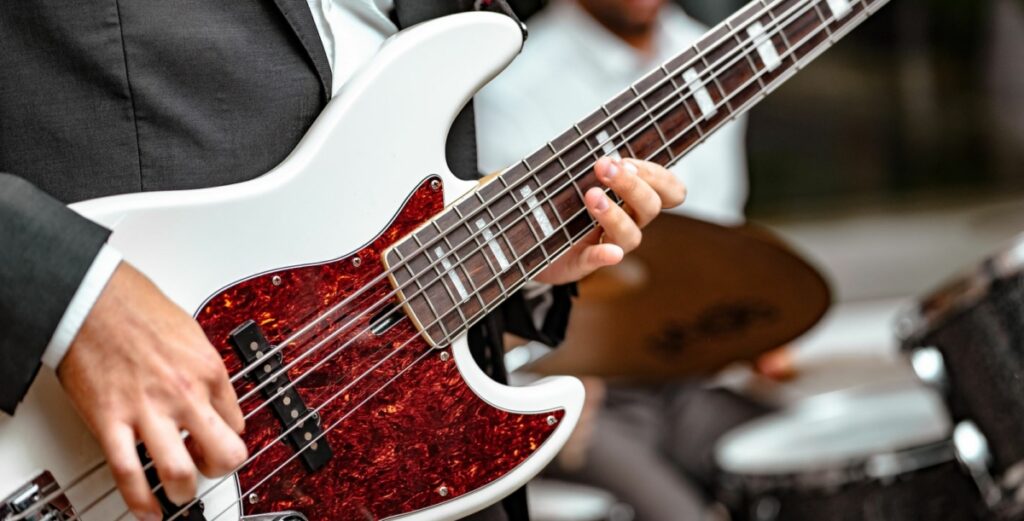The scale length of a bass guitar is the distance between the bridge and the nut. This is also commonly referred to as the string length. There are two main types of bass guitar: short-scale and long-scale (aka standard-scale). So how does this affect the tone and feel of the instrument?
Short-scale basses have a scale of 30″ whereas long-scale basses have a scale of 34″. Short-scale basses sound warmer and fuller compared to long-scale basses which sound brighter and more focused. Short-scale basses also have closer fret spacing, and smaller bodies compared to long-scale basses.
| Short-Scale Bass | Long-Scale Bass |
| 30” scale length | 34” scale length |
| Warm tone with more low-end | Brighter and more focused sound |
| Frets are spaced more closely | Frets are spaced further apart |
| Strings are under less tension | Strings are under more tension |
| Smaller body | Larger body |
| Typically weigh 7-8 lbs | Typically weigh 9-10 lbs |
| E.g. Fender Mustang Bass | E.g. Fender P Bass and J Bass |

What is a Long-Scale Bass?
Long-scale bass guitars have a scale length of 34″. This is considered the standard-size for a bass guitar and is also sometimes referred to as “full-scale”.
Examples of long-scale basses include:
- Fender Jazz Bass
- Fender Precision Bass
- Sterling by Music Man Stingray
Famous bass players who use a short-scale bass include:
- Flea
- Geddy Lee
- Steve Harris

What is a Short-Scale Bass?
Short-scale bass guitars typically have a scale length of 30″ which is 4″ shorter than the long-scale bass. Some short-scale basses have a scale which is slightly shorter or longer than this (by 1″ or less) however the standard is considered 30″.
Examples of short-scale basses include:
- Fender Mustang
- Sterling by Music Man Stingray Short Scale
- Gibson SG Standard Bass
Famous bass players who use a short-scale bass include:
- Paul McCartney
- Jack Bruce
- Bill Wyman

Tonal Differences
Short-scale bass guitars sound fatter and more rounded compared to long-scale basses which have a more defined and clearer tone.
- Short-scale bass = mellow and warm
- Long-scale bass = tight and focused
The upper harmonics are less prevalent on a short-scale bass which results in a warmer tone as there is more low-end emphasis.
If you are looking for more brightness and articulation, then you’ll prefer the tone of a long-scale bass. However, if you want a beefy, booming tone then you’ll prefer the sound of a short-scale bass.
Check out this YouTube video comparing the tone of a Jazz Bass (long-scale) and Mustang Bass (short-scale). For the best comparison, listen to the bridge pickup as both these basses have a single coil in the bridge.
Feel and Playability
There are several differences between long-scale and short-scale basses which affect how they feel to play:
- Neck Size
- Fret spacing
- String tension
- Body size
- Weight
Neck Size
Given that short-scale basses have shorter necks, the player does not have to reach as far to get to the lower frets compared to with a long-scale bass. This can make short-scale basses feel a lot more manageable in comparison, particularly if the player is transitioning from an electric guitar.
It’s also true that short-scale basses typically have thinner necks compared to long-scale basses. Neck depth is a personal preference and really depends on your hand size and how you feel comfortable positioning it, so there’s no real “best” option.
Fret Spacing
The space between the frets is narrower on a short-scale bass compared to a long-scale bass where the frets are spaced further apart.
Take the Fender Mustang and Jazz Basses as examples.
- The Fender Mustang has 19 frets
- The Fender Jazz Bass has 20 frets
Since the Mustang is 4″ shorter, it has fewer frets to compensate. However, the frets are still spaced more closely together because the typically distance between frets is less than 4″. Take the distance between the 1st and 2nd fret as an example.
- On a Fender Mustang, the 1st and 2nd frets are spaced 1.68″ apart
- On a Fender Jazz Bass, the 1st and 2nd frets are spaced 1.90″ apart

This means that you’ll need to stretch your fingers more to move between frets, which can feel more challenging especially if you have smaller fingers. This is why many bass players find fast riffs easier to perform on a short-scale bass.
Equally though, if you’re using the higher frets more often then you might actually prefer the spacing on a long-scale bass as there’s more room for your fingers between frets.
Short-scale basses are also easier to transition to from an electric guitar, compared to long-scale basses. Electric guitars typically have a scale of around 25″, which is much shorter than a bass guitar, hence a short-scale bass is easier to transition to.
String Tension
The scale length of a bass guitar affects the tension that the strings are under.
- Long-scale bass guitars = strings are under more tension
- Short-scale bass guitars = strings are under less tension
This means that the strings will feel easier to fret on a short-scale bass, which again can make them feel easier to play. However, when the strings are under less tension, they are also more likely to cause fret buzz and less tuning stability.
It’s important to note that the gauge (thickness) of the strings used also affects the tension they are under. Thicker strings are under more tension than thinner strings. Hence, some players will actually use thicker strings on a short-scale bass to compensate for the lack of tension caused by the shorter scale.
Body Size
Short-scale bass guitars typically also have smaller bodies compared to long-scale basses in order to make sure the bass is still well-balanced. This can make short-scale basses feel a bit more manageable, particularly if the player has quite a small frame.
Take the Mustang Bass (short-scale) and Jazz Bass (long-scale) as an example. Here are the body dimensions for both.
| Body Dimension | Mustang Bass | Jazz Bass |
| Length | 18” | 20.5” |
| Width (widest point) | 12.25” | 13.5” |
| Depth | 1.50” | 1.75” |
Weight
Given that short-scale basses are smaller both in terms of the scale and body dimensions, they are also typically lighter than long-scale basses. This again can make the short-scale bass easier to play (sitting or standing) for longer periods of time.
Here are some examples to show the weight differences.
| Bass Guitar | Average Weight |
| Short Scale Examples | |
| Mustang Bass | 7.5 lbs |
| Gibson SG Bass | 7.8 lbs |
| StingRay Short Scale | 8.0 lbs |
| Long Scale Examples | |
| Precision Bass (Long Scale) | 9.0 lbs |
| Jazz Bass (Long Scale) | 9.0 lbs |
| StingRay (Long Scale) | 10.0 lbs |

Other Bass Scales
There are also a couple of different scale classifications we’ve not mentioned yet: medium-scale and extra-long scale.
- Medium-scale basses have a scale-length of 32″
- Extra-long scale basses have a scale length of 35″-36″
Medium-scale basses offer a compromise between long-scale and short-scale basses both in terms of tone and playability. If you find that you prefer the tone of a long-scale bass but the feel of a short-scale bass, then medium-scale basses are a good option to consider.
Extra-long scale basses typically have 5 or 6 strings. The reason for this extra-long scale is that it increases the tension and stops the lower strings from becoming too loose.
Which Bass Scale-Length Should You Choose?
Short-scale basses are easier for most players to use compared to long-scale basses, as they are more condensed and the strings are under less tension. However, some players much prefer the tone of a long-scale bass which is the industry-standard.
I’d advise trying both in store if you are able to. Even if you are a total beginner and can’t play anything yet, you’ll be able to get a feel for which is more comfortable to you.
Here are some general points to consider to help you make your decision.
Short-scale bass guitars are typically best for:
- Beginner bass players or guitarists transitioning to bass
- Children/ teens or adults with smaller frames
Long-scale bass guitars are typically best for:
- Those who want the classic bass tone used by most professionals
- Players who prefer wider fret spacing
Here are some more articles that you might find useful:
